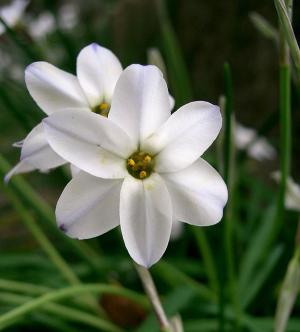Spring starflowers are great for massing in front of flowerbeds
In the galaxy of gardening, several stars shine brightly. And like the heavenly bodies, stars in the garden seem to just appear without the help of man. The best flowers, like the best star actors, make it apear effortless.
An easy-to-grow, twinkling flower that often gets overlooked is the spring starflower (Ipheion uniflorum).
This native of Argentina and Uruguay begins to sprout in very early spring with slender, foot-long grassy leaves followed by single star-shaped flowers atop six-inch-tall stems.
Every bulb produces several flowering stems for an airy display.
The blossoms range in color from nearly white to deep violet blue. The flowers have a mild, spicy fragrance, and the leaves when bruised have a whiff of onions or chives.
Spring starflowers are great when massed in front of flowerbeds, tucked into rock gardens, strung along paths or sidewalks, or set in front of hedges or shrubs. You can even scatter them in lawns where they can naturalize over the years.
In addition to the wild forms, there are several named varieties. You might try Jessie, the darkest blue of all, or the clear lilac blue Wisley Blue.
The intense blue Rolf Fiedler has larger blooms, so it is a bit showier than most. Dark violet Froyle Mill contrasts nicely with white varieties such as the large-flowered white Alberto Castillo. All of these easy-to-grow flowers can bloom for up to eight weeks.
If you can't find spring starflowers locally, try specialty bulb houses such as American Meadows (www.americanmeadows.com), or White Flower Farm (www.whiteflowerfarm.com or phone 800-503-9624), among others. Plant the small bulbs two inches deep, two to four inches apart in the fall. Choose a spot that gets full sun to partial shade. While they grow best with a soil pH between 6.1 and 7.8, they are really not fussy about soil as long as it drains well.
They even tolerate clay soil, and are one of the few flowers not affected by the soil toxins released by black walnut trees. They are deer and rodent resistant.
You can pot some up for a cheerful, long-flowering indoor plant. Indoors they do best in a cooler area away from drafts. Starflowers are hardy in USDA zones 5 to 9.
Pair spring starflowers with daffodils and grape hyacinths (muscari) for a pleasant long-lasting display that will go on for years. Best of all. spring starflowers naturalize or spread quickly from bulb offsets and self-seeding.
As with all naturalizing bulbs, let the foliage die down naturally before mowing or cutting back. The plants will go dormant after blooming and disappear until next spring when they will burst forth like a supernova.
Plant spring starflowers this fall, and you may be star-struck when they bloom next year for a performance with a cast of thousands, every one a star.























































